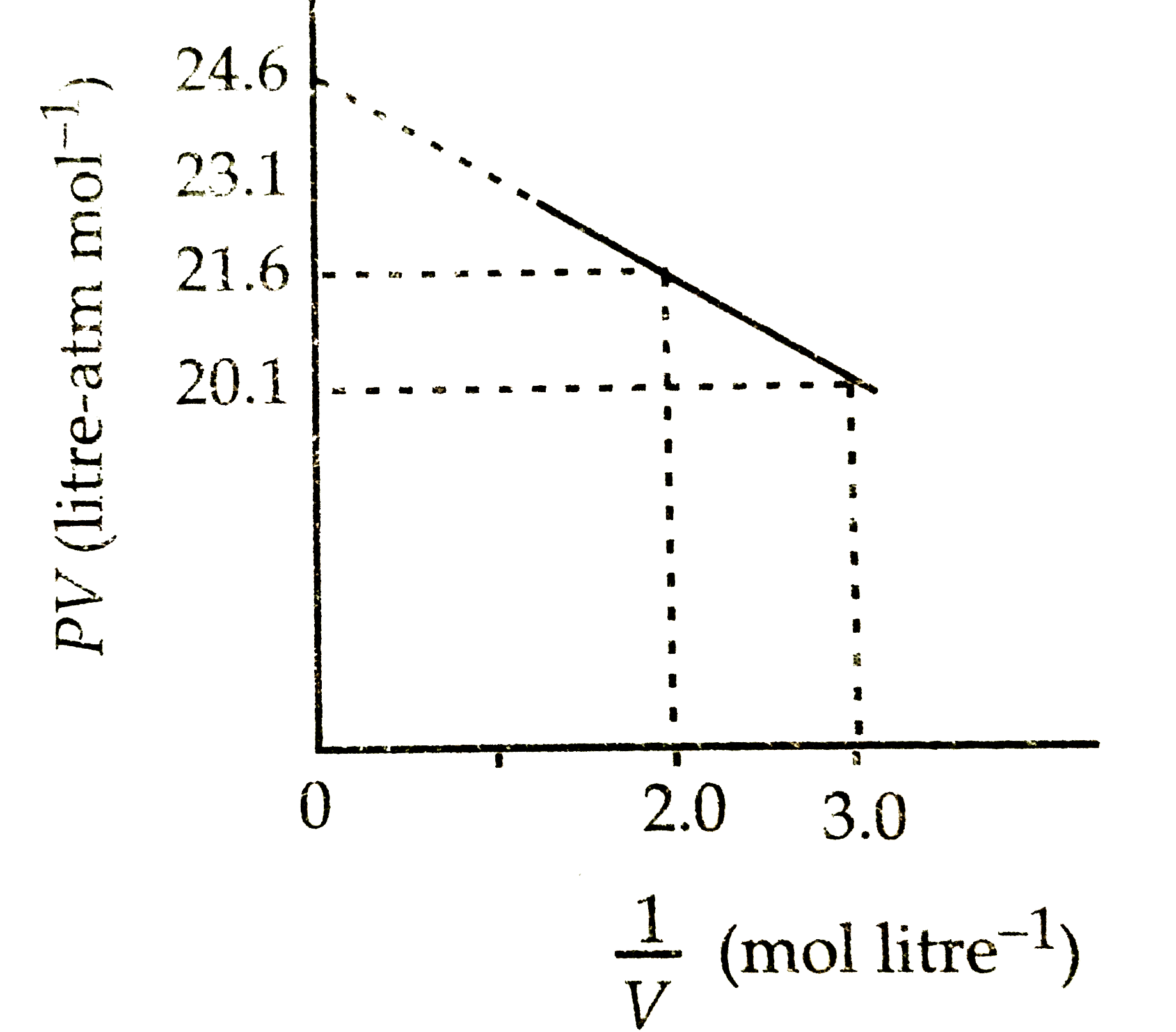For a real gas (mol.mass =60) if density at critical point is 0.80g/cm−3 and its Tc=4×105821K, then van der Waals' constant a ( in atm L2mol−2) is
0.3375
3.375
1.68
0.025
The correct Answer is:b
To find the Van der Waals constant a for the given real gas, we will follow these steps:
Step 1: Calculate the Molar Volume at the Critical Point
Given:
- Molar mass M=60g/mol
- Density at the critical point ρ=0.80g/cm3
Using the formula for density:
ρ=MV
we can rearrange it to find the molar volume V:
V=Mρ
Substituting the values:
V=60g/mol0.80g/cm3=75cm3/mol
Converting to liters:
V=75cm3/mol=0.075L/mol
Step 2: Calculate the Van der Waals Constant B
The critical volume Vc is related to the Van der Waals constant B by:
Vc=3B
Thus, we can find B:
B=Vc3=0.075L/mol3=0.025L/mol
Step 3: Calculate the Critical Temperature Tc
Given:
Tc=4×105821K
Calculating Tc:
Tc≈487.7K
Step 4: Use the Van der Waals Equation to Find a
The relationship between the critical temperature Tc, the Van der Waals constant a, the universal gas constant R, and B is given by:
Tc=8a27Rb
Rearranging to solve for a:
a=27RbTc8
Substituting the known values:
- R=0.0821L atm/(K mol)
- B=0.025L/mol
- Tc≈487.7K
Calculating a:
a=27×0.0821L atm/(K mol)×487.7K×0.025L/mol8
Calculating the numerator:
=27×0.0821×487.7×0.025≈2.5L2atm/mol2
Now dividing by 8:
a≈2.58≈0.3125L2atm/mol2
Final Result
The Van der Waals constant a is approximately 3.375L2atm/mol2.
Given:
- Molar mass M=60g/mol
- Density at the critical point ρ=0.80g/cm3
ρ=MV
we can rearrange it to find the molar volume V:
V=Mρ
Substituting the values:
V=60g/mol0.80g/cm3=75cm3/mol
Converting to liters:
V=75cm3/mol=0.075L/mol
The critical volume Vc is related to the Van der Waals constant B by:
Vc=3B
Thus, we can find B:
B=Vc3=0.075L/mol3=0.025L/mol
Given:
Tc=4×105821K
Calculating Tc:
Tc≈487.7K
The relationship between the critical temperature Tc, the Van der Waals constant a, the universal gas constant R, and B is given by:
Tc=8a27Rb
Rearranging to solve for a:
a=27RbTc8
Substituting the known values:
- R=0.0821L atm/(K mol)
- B=0.025L/mol
- Tc≈487.7K
a=27×0.0821L atm/(K mol)×487.7K×0.025L/mol8
Calculating the numerator:
=27×0.0821×487.7×0.025≈2.5L2atm/mol2
Now dividing by 8:
a≈2.58≈0.3125L2atm/mol2
The Van der Waals constant a is approximately 3.375L2atm/mol2.
Topper's Solved these Questions
- GASEOUS STATEBOOK - NARENDRA AWASTHI ENGLISHCHAPTER - GASEOUS STATEEXERCISE - Level 3 Passage 1
4 Videos
- GASEOUS STATEBOOK - NARENDRA AWASTHI ENGLISHCHAPTER - GASEOUS STATEEXERCISE - Level 3 Passage 2
6 Videos
- GASEOUS STATEBOOK - NARENDRA AWASTHI ENGLISHCHAPTER - GASEOUS STATEEXERCISE - Subjective problems
15 Videos
- ELECTROCHEMISTRYBOOK - NARENDRA AWASTHI ENGLISHCHAPTER - ELECTROCHEMISTRYEXERCISE - Subjective problems
14 Videos
- IONIC EEQUILIBRIUMBOOK - NARENDRA AWASTHI ENGLISHCHAPTER - IONIC EEQUILIBRIUMEXERCISE - Subjective problems
1 Videos
Similar Questions
1 mole of a diatomic gas present in 10 L vessel at certain temperature exert a pressure of 0.96 atm. Under similar conditions an ideal gas exerted 1.0 atm pressure. If volume of gas molecule is negligible, then find the value of van der Waals' constant ''a'' (in atm L2/mol2).
View SolutionFor one mole of a van der Waals gas when b = 0 and T = 300 K , the PV vs 1/V plot is shown below . The value of the van der Waals constant a (atm litre2mol−2) is

View SolutionCalculate the molecular diameter of helium from its van der Waals constant b. (b=24cm3mol−1)
View SolutionAt what temperature will 128 g of SO2 confined in a vessel of 5dm3 capacity exhibit a pressure of 10.0 bar? The van der waals constants for SO2 are a = 6.7 bar L2mo≤−2 and b = 0.0564 Lmol−1.
View Solution
The table indicates the value of vander Waal's constant a in L2 atm mol−2. The gas which can most easily be liquefied is ?
View SolutionThe correct order of normal boiling of O2,N2,NH3 and CH4 for whom the values of van der Waals constant 'a' are 1.360,1.390,4.170 and 2.253L2atmmol−2 respectively, is:
View SolutionCalculate the pressure exerted by 110 g of carbon dioxide in a vessel of 2 L capacity at 37∘C. Given that the van der Waal’s constants are a=3.59L2 atm mol−2andb=0.0427Lmol−1. Compare the value with the calculated value if the gas were considered as ideal.
View SolutionCalculate critical temperature and critical pressure of oxygen if the values of the van der Waal's constants a and b are 1.32dm6barmol−2 and 0.0312dm3mol−1 respectively.
View SolutionRate constant k=1.2×103mol−1Ls−1 and Ea=2.0×102kJmol−1. When T→∞:
View SolutionThe van der Waals constants for a substance are a=300.003kPadm6mol−2 and b=40.8cm3mol−1. Find the critical constants of this substance.
View Solution
